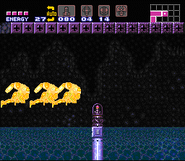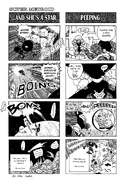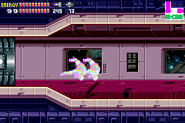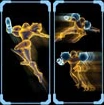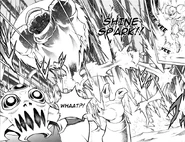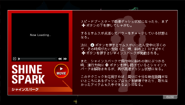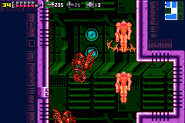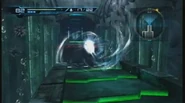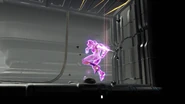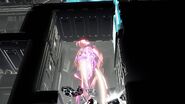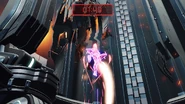| This is a featured article. |
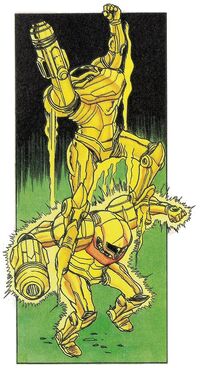
Artwork of the Shinespark in Super Metroid.
The Shinespark[1][2][3] or Shine Spark[4][5] is a hidden move Samus can execute after collecting the Speed Booster power. It has appeared in every game with that item, starting with Super Metroid. It was originally taught to her by the Dachora on Zebes.
The 59th issue of Nintendo Power, which contained previews for Super Metroid, referred to the Shinespark as the Speed Booster Blast, because Nintendo hadn't given it an official name yet. Super Metroid Nintendo Player's Guide refers to it as the Super Jump. The Sector 4 conversation in Metroid Fusion marks the first official use of the "Shinespark" name.
Details[]
A Shinespark is performed by activating the Speed Booster, crouching, and then jumping. When jumping, Samus can choose to aim the Shinespark in one of five directions; these directions are left, diagonal up-left, up, diagonal up-right, and right. The process must not be interrupted if the Shinespark is to be performed successfully. Once she has stored a charge by crouching, Samus may stand up and move around as usual with the exception of jumping normally, which will activate the Shinespark. This may be avoided by performing a Spin Jump, which does not activate the technique. While Samus cannot fire any beams while doing a Shinespark, a charged beam can be maintained during a Shinespark in Metroid: Zero Mission. A charge expires after five seconds if not used.
Samus can also Shinespark in mid-spin jump. In order to do this, she must store a Speed Booster charge as usual. After spin jumping into the air, she must look up, down, or fire a beam to stop the spin. Once she has stopped spinning, attempting to jump again will activate the Shinespark; again, the Shinespark can fly in any of the five previously mentioned directions.
In Super Metroid, when Samus uses the Shinespark, her speed increases. This feature is not present in Metroid Fusion, Metroid: Zero Mission, or Metroid Dread.
If a Shinespark is performed horizontally against a slope in Metroid Fusion, Metroid: Zero Mission, or Metroid Dread, Samus will begin to run along the slope at full speed (in Super Metroid this is not possible; Samus will simply continue flying by sliding across the slope). This feature debuted in Metroid Fusion and is key in performing multiple Shinesparks in a row.
Metroid: Zero Mission introduced the Ball Spark, which is basically the same technique but performed in Morph Ball form. Once again, hitting a sloped edge while using the Ball Spark will cause Samus to continue at high speeds until she collides with a flat surface. Pressing down once this has occurred will store a charge for another Ball Spark. The Morph Ball launchers introduced in the same game allow Samus to instantly activate a vertical Ball Spark.
A very complicated series of Shinesparks can be attempted in Metroid Fusion to see a secret message. It is one of the very few sequence breaks in this game. Another complex series of Shinesparks and Ball Sparks can be used in Metroid: Zero Mission to obtain the Super Missiles much earlier than normal.
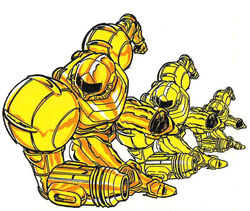
Artwork for the Shinespark.
In Super Metroid, performing a Shinespark decreases Samus' energy very quickly, thereby rendering the Shinespark feature useless when Samus has only 29 or less energy left. If Samus runs low on energy in mid-Shinespark, she will act as if she had collided with a wall; this will also occur if she tries to activate another Shinespark before regaining any energy. Additionally, the end of a Shinespark in Super Metroid releases a shockwave perpendicular to Samus' trajectory a few seconds after she impacts something; this shockwave takes the form of "afterimages" of Samus. On contact, the shockwave deals damage comparable to that of the Shinespark itself, but it does not always affect enemies vulnerable to the Shinespark. Occasionally, the Shinespark tends to angle differently than normal, often to hit an unaware, nearby enemy. Metroid games after Super Metroid do not feature either of these aspects of the Shinespark.
The Samus Screen in Metroid: Other M shows the Shinespark listed underneath the Speed Booster as a secondary ability. The Shinespark is performed by building up a Speed Booster charge and then jumping in a direction. In this iteration, the move is more of a long jump than a continuous boost. Nightmare is fought in a room which allows the use of the Shinespark, which can be used to damage it.
Shinespark and Ball Spark puzzles are present in Metroid Dread. Samus can also now Shinespark downward, allowing her a full eight directions of Shinesparking. Using a vertical Shinespark in certain situations, specifically the Dairon E.M.M.I. Zone, the Experiment No. Z-57 battle, and the countdown in Hanubia, will trigger a unique dynamic camera angle for added visual effect. Additionally, the Shinespark is an incredibly potent weapon for dealing heavy damage during boss battles, such as against Escue, Golzuna, Robot Chozo Soldiers, and Central Units, and it can even kill Experiment No. Z-57 instantly during its second phase.
During the third phase of his boss battle, Raven Beak is capable of using vertical and horizontal Shinesparks as attacks. Unlike Samus, he can immediately initiate the Shinespark from a standing position and therefore does not need to activate the Speed Booster first. The move is telegraphed by him hovering slightly off the ground while engulfed in a blue aura. While Shinesparking, Raven Beak adopts a "shoulder tackle" pose similar to Samus.
Other appearances[]
Non-canon warning: This article or section contains information that may not be considered an official part of the Metroid series in the overall storyline by Nintendo.
Super Smash Bros.[]
While Samus is unable to use the Shinespark in her Super Smash Bros. moveset (not counting the below Smash Run Power), her Dash Attack has her adopting a pose nearly identical to her horizontal Shinespark pose from Super Metroid.
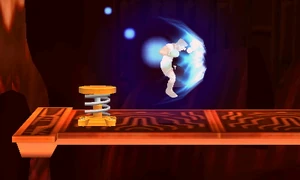
Little Mac uses the Shinespark in Smash Run.
In Super Smash Bros. for Nintendo 3DS, special Powers are available to characters for use in Smash Run to enable such effects as healing damage. One of these Powers is use of the "Shinespark". Despite the name, all it is an increase in running speed and the ability to plow through enemies like running with the normal Speed Booster. The fighter using this Power is enveloped in a field of energy that lasts for a limited time. Various upgrades to the power cause it to have more uses, but also take up more space in each character's Weight Limits. The sound effects made by this Power are original and not taken from any Metroid games.
Non-canon warning: Non-canonical information ends here.
Official data[]
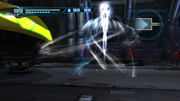
A Vertical Shinespark in Metroid: Other M.
Super Metroid Nintendo Player's Guide[]
- JUMP
- "Performing a Super Jump will be critical to finishing your mission and essential to obtaining every single Item. There are some Items that you simply can't get to if you can't Super Jump. A Dachola will clue you in on how to execute the jumping technique. You must first have the Speed Booster. Activate the Speed Booster to run quickly. Once you are at full speed and are in the area where you want to jump, press Down. Samus will begin to flash. Press the Jump Button to perform the Super Jump.
If you have enough room to activate the Speed Booster, the Super Jump will take you where you need to go!"
Nintendo Power Volume 59[]
- SPEED BOOSTER BLAST
- "When Samus has hit full stride with the Speed Booster, she can kneel down then rocket skyward."
Metroid.com (Metroid: Other M)[]
"With a boost of speed comes incredible jumping abilities. Capitalizing on that momentum, the Shinespark technique launches Samus into the air at hyper speed."
Metroid: Other M manual[]
- Shinespark
- "While speed boosting, press and release the 2 Button to perform a powerful jump. If you aren't pressing the +Control Pad in any direction when you release the 2 Button, you'll jump straight up. Press the +Control Pad when you release the 2 Button to jump in any direction."
Metroid: Other M Samus Screen[]
"Controls: Press and hold [2] while speed boosting.
Release [D-Pad] and [2] to jump vertically.
Press [D-Pad] and release [2] to jump in a direction.
Metroid: Other M On-Screen Tutorial[]
"SHINESPARK
Press and hold [2] with Speed Boost activated. Aim with [D-Pad] and release [2]."
"SHINESPARK
Press and hold [2] while speed boosting and release [2] without pressing [D-Pad] to fly straight upward."
Metroid: Other M Premiere Edition[]
- Shinespark
- "Shinespark is a very useful ability that you gain at the same time as the Speed Booster upgrade. With Shinespark, you can jump great distances at super speed. This allows you to leap dozens of feet in the air and reach distant areas. And since you're travelling at super speed, you can also break through objects and barriers as you go."
Super Smash Bros. for Nintendo 3DS[]
"Increases your running speed. When you start to shine, you can also deliver a body blow."
Metroid Dread Report Volume 6[]
"This ability can only be used once Samus has reached her Speed Booster state. She can send herself soaring on a straight trajectory in the direction of her choosing. When soaring, she can blast through certain obstacles and deal great damage to enemies."
Nintendo of America tweets[]
"Samus’ movement in #MetroidDread is smooth as ever. Pick up the pace with the Speed Booster ability, building speed with the ability to smash through certain obstacles & enemies.
Once in Speed Booster state, she can use Shinespark to soar in a chosen direction with great speed."[6]
"Who’s ready to Shinespark into the weekend and play some #MetroidDread?"[7]
Metroid Dread loading screen tip[]
- SHINESPARK
- During a Shinespark, if you collide with a sloped surface, tilt
 in the direction you're heading to automatically transition to a Speed Booster run.
in the direction you're heading to automatically transition to a Speed Booster run.
Trivia[]
- The Super Metroid manual does not make any mention of this technique.
- While Samus monologues in Metroid Fusion that she was taught the Shinespark by the Dachora, implicitly during her Raid on Planet Zebes (in Super Metroid), she is retroactively able to fully utilize this ability during her Zero Mission (in Metroid: Zero Mission), which takes place before Super Metroid. It is never necessary to Shinespark in order to finish Zero Mission, but Samus does need to use the technique several times in order to obtain all items in the game.
- In Other M, Samus seems to be spinning constantly while propelling herself forward while using the Shinespark, unlike in other games where she faces the same direction. This can be seen in the spiral trail the Shinespark leaves. Additionally, if she performs a vertical Shinespark but misses the target and hits her head on an object, then she will continue to rotate slowly before falling. Samus also spins in Zero Mission, but only when performing a vertical Shinespark.
- In Metroid Dread, by preparing a Shinespark, performing at least one Flash Shift, and finally Shinesparking while firing the Grapple Beam, Samus will perform a glitch that is unofficially known as the Shine Sink.
- The Shinespark is a reference, in both name and function, to the signature finishing move of the 1975 anime Getter Robo G's Getter Dragon.
- Although the Shinespark received its name in Metroid Fusion, Metroid Fusion: The Official Nintendo Player's Guide instead refers to the Shinespark as the Speed Booster's "charged-up rocket launch".
- Shinesparkers, a Metroid fansite launched in 2010, is named after the Shinespark technique. Its logo as of September 2018 features the Speed Booster icon.
- Visual effects for the Shinespark in Dread were done by Rafael Machó Alcaraz[8].
Gallery[]
References[]
- ^ Metroid Fusion Sector 4 conversation
- ^ Metroid: Other M Samus Screen and on-screen tutorial
- ^ Metroid Dread Samus Screen
- ^ Metroid Zero Mission Official Site Super Technique
- ^ Metroid Dread Report/Volume 11: Power through with these pointers for exploration and combat
- ^ Nintendo of America (NintendoAmerica). 2 September 2021 3:05 p.m. Tweet. https://twitter.com/NintendoAmerica/status/1433506280396759047
- ^ Nintendo of America (NintendoAmerica). 8 October 2021 6:55 p.m. Tweet. https://twitter.com/NintendoAmerica/status/1446610181643649024
- ^ Doeboy. "MercurySteam Dev is here!! - Metroid Dread Hard Mode [1/2]". YouTube. October 26, 2021. Retrieved February 24, 2022.
| Special Actions | |
|---|---|
| Suit | Moon Walk • Spin Jump Attack • Wall Jump • Spin Jump • Crystal Flash • Shinespark • SenseMove Counter Attack • Search View • Strafe/Dash • Slide (Slide Jump) • Parkour |
| Arm Cannon | Special Charge Beam Attacks • Headshot • Lock-on • Welding • Overblast • Lethal Strike • Concentration Precision Aiming • Free Aim • Melee Counter |
| Morph Ball | Bomb Jump • Bomb-Trick • Five-Bomb Drop • Turbo Bomb • Ball Spark • Boost Jump • Boost Charge Spider Boost • Tower Jump |
| See also | Super Smash Bros. moves • Glitches • Sequence Breaking |


